NUR3101: Comparing Primary Health Care Strategies Globally & Nursing
VerifiedAdded on 2023/06/04
|11
|3075
|331
Essay
AI Summary
This essay presents a comprehensive analysis of primary health care in a global context, comparing strategies and principles across different countries. It examines the social determinants of health, environmental factors, and population health issues, including outbreaks and epidemics, and critically analyzes their impact on nursing practice and cultural competence. The essay highlights the importance of equity and social justice in healthcare delivery, emphasizing the need for person-centered and evidence-based solutions that nurses can contribute to in their roles as primary health care providers for the prevention of illness and promotion of optimal health. The discussion incorporates the World Health Organization's key principles of primary health care, focusing on their significance in addressing global health challenges and improving healthcare access for all individuals, especially those in remote and underserved communities.
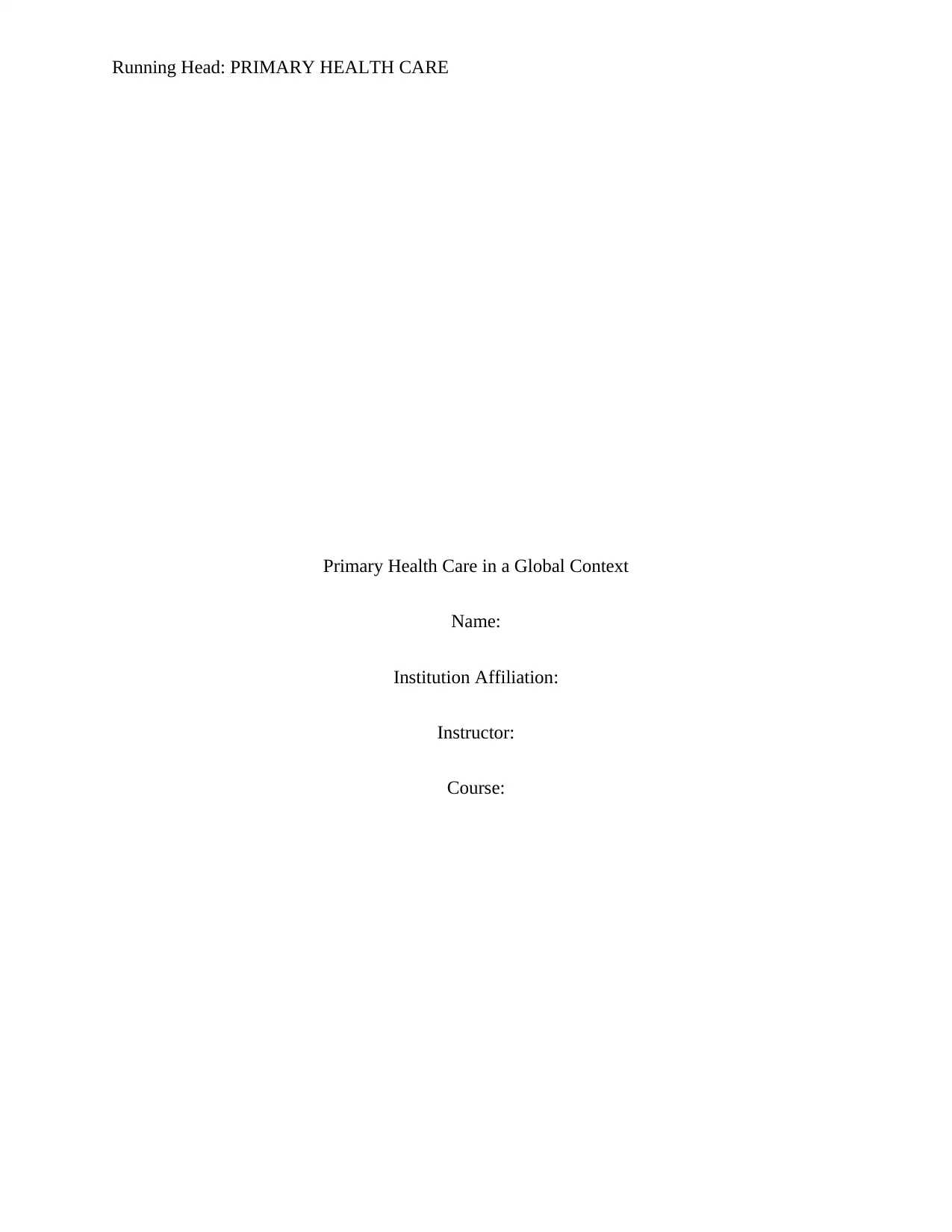
Running Head: PRIMARY HEALTH CARE
Primary Health Care in a Global Context
Name:
Institution Affiliation:
Instructor:
Course:
Primary Health Care in a Global Context
Name:
Institution Affiliation:
Instructor:
Course:
Paraphrase This Document
Need a fresh take? Get an instant paraphrase of this document with our AI Paraphraser
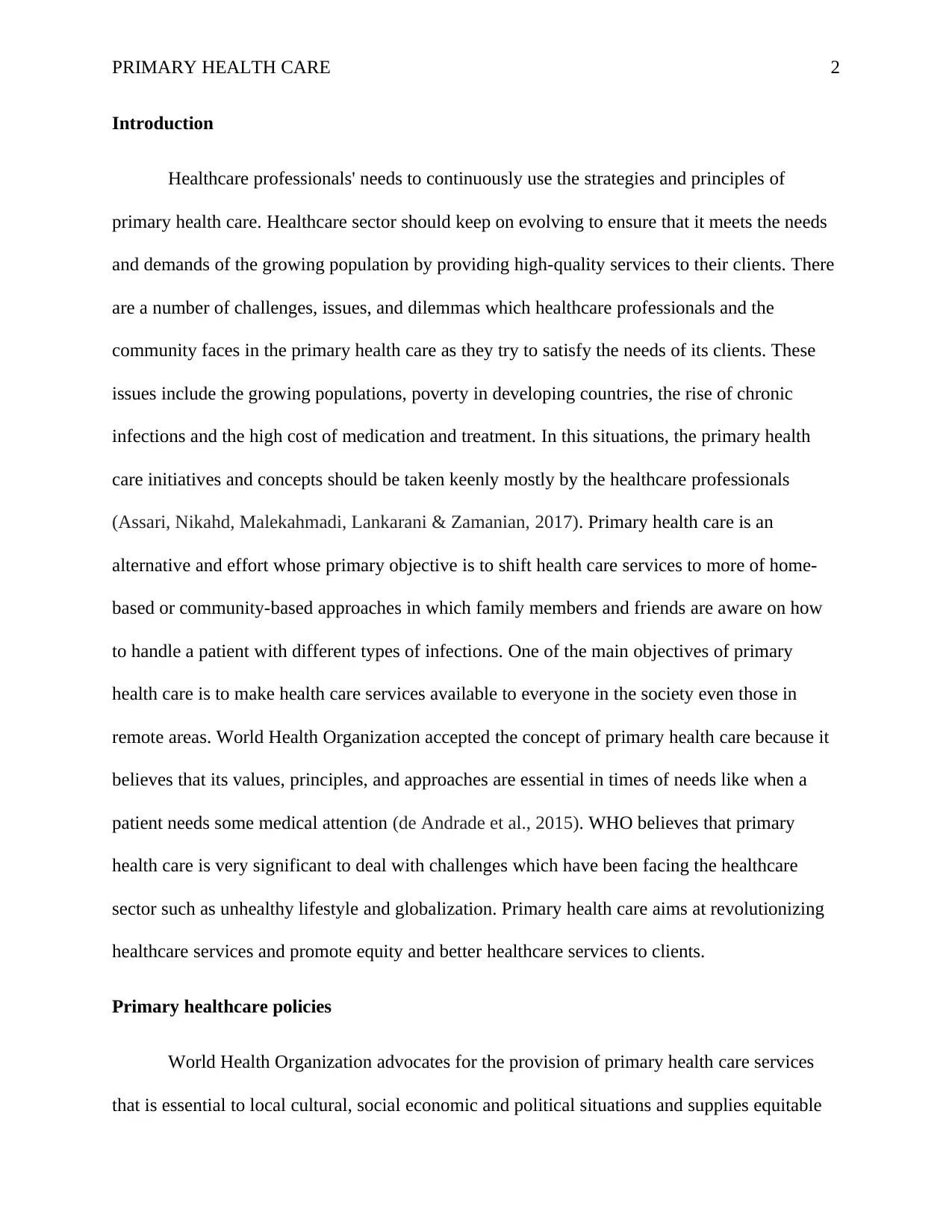
PRIMARY HEALTH CARE 2
Introduction
Healthcare professionals' needs to continuously use the strategies and principles of
primary health care. Healthcare sector should keep on evolving to ensure that it meets the needs
and demands of the growing population by providing high-quality services to their clients. There
are a number of challenges, issues, and dilemmas which healthcare professionals and the
community faces in the primary health care as they try to satisfy the needs of its clients. These
issues include the growing populations, poverty in developing countries, the rise of chronic
infections and the high cost of medication and treatment. In this situations, the primary health
care initiatives and concepts should be taken keenly mostly by the healthcare professionals
(Assari, Nikahd, Malekahmadi, Lankarani & Zamanian, 2017). Primary health care is an
alternative and effort whose primary objective is to shift health care services to more of home-
based or community-based approaches in which family members and friends are aware on how
to handle a patient with different types of infections. One of the main objectives of primary
health care is to make health care services available to everyone in the society even those in
remote areas. World Health Organization accepted the concept of primary health care because it
believes that its values, principles, and approaches are essential in times of needs like when a
patient needs some medical attention (de Andrade et al., 2015). WHO believes that primary
health care is very significant to deal with challenges which have been facing the healthcare
sector such as unhealthy lifestyle and globalization. Primary health care aims at revolutionizing
healthcare services and promote equity and better healthcare services to clients.
Primary healthcare policies
World Health Organization advocates for the provision of primary health care services
that is essential to local cultural, social economic and political situations and supplies equitable
Introduction
Healthcare professionals' needs to continuously use the strategies and principles of
primary health care. Healthcare sector should keep on evolving to ensure that it meets the needs
and demands of the growing population by providing high-quality services to their clients. There
are a number of challenges, issues, and dilemmas which healthcare professionals and the
community faces in the primary health care as they try to satisfy the needs of its clients. These
issues include the growing populations, poverty in developing countries, the rise of chronic
infections and the high cost of medication and treatment. In this situations, the primary health
care initiatives and concepts should be taken keenly mostly by the healthcare professionals
(Assari, Nikahd, Malekahmadi, Lankarani & Zamanian, 2017). Primary health care is an
alternative and effort whose primary objective is to shift health care services to more of home-
based or community-based approaches in which family members and friends are aware on how
to handle a patient with different types of infections. One of the main objectives of primary
health care is to make health care services available to everyone in the society even those in
remote areas. World Health Organization accepted the concept of primary health care because it
believes that its values, principles, and approaches are essential in times of needs like when a
patient needs some medical attention (de Andrade et al., 2015). WHO believes that primary
health care is very significant to deal with challenges which have been facing the healthcare
sector such as unhealthy lifestyle and globalization. Primary health care aims at revolutionizing
healthcare services and promote equity and better healthcare services to clients.
Primary healthcare policies
World Health Organization advocates for the provision of primary health care services
that is essential to local cultural, social economic and political situations and supplies equitable
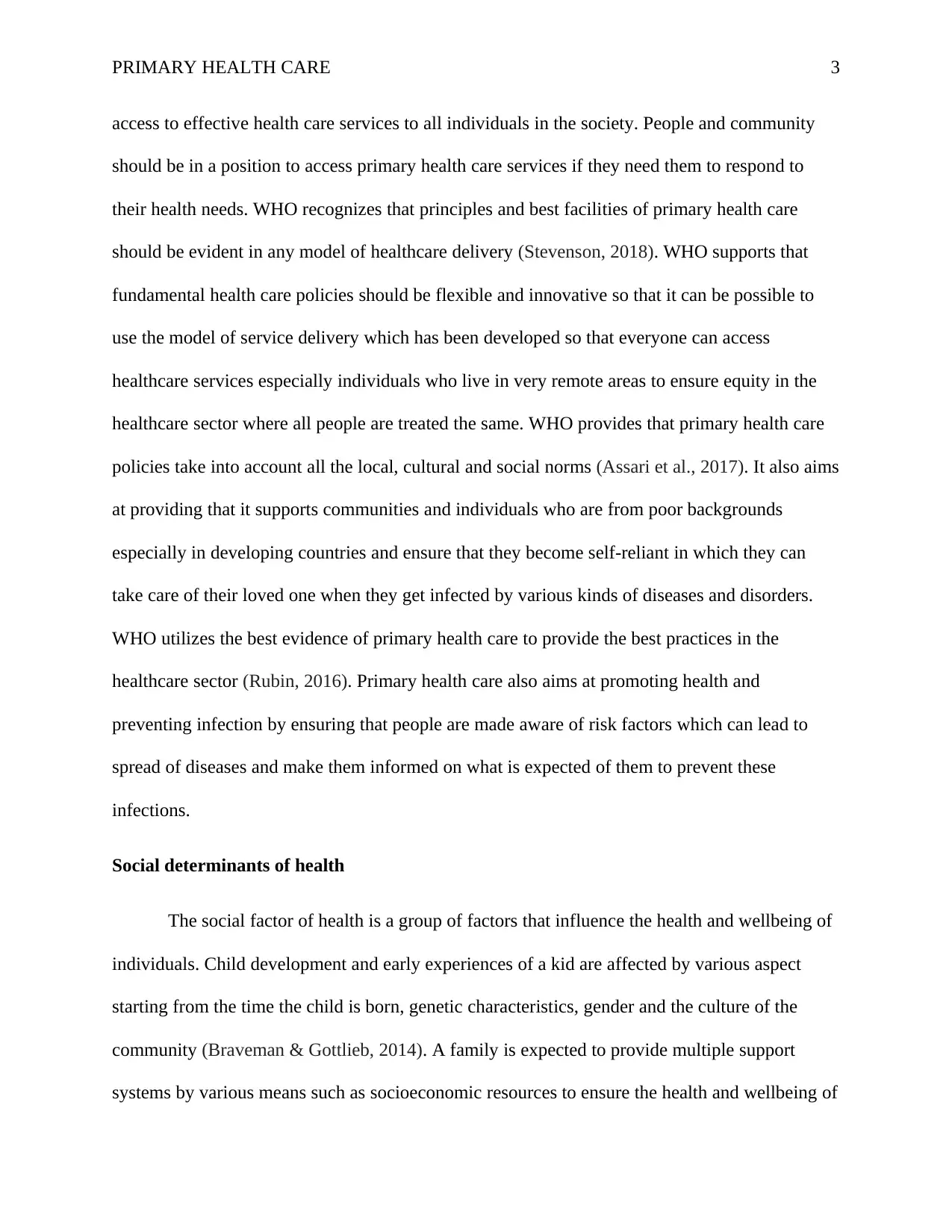
PRIMARY HEALTH CARE 3
access to effective health care services to all individuals in the society. People and community
should be in a position to access primary health care services if they need them to respond to
their health needs. WHO recognizes that principles and best facilities of primary health care
should be evident in any model of healthcare delivery (Stevenson, 2018). WHO supports that
fundamental health care policies should be flexible and innovative so that it can be possible to
use the model of service delivery which has been developed so that everyone can access
healthcare services especially individuals who live in very remote areas to ensure equity in the
healthcare sector where all people are treated the same. WHO provides that primary health care
policies take into account all the local, cultural and social norms (Assari et al., 2017). It also aims
at providing that it supports communities and individuals who are from poor backgrounds
especially in developing countries and ensure that they become self-reliant in which they can
take care of their loved one when they get infected by various kinds of diseases and disorders.
WHO utilizes the best evidence of primary health care to provide the best practices in the
healthcare sector (Rubin, 2016). Primary health care also aims at promoting health and
preventing infection by ensuring that people are made aware of risk factors which can lead to
spread of diseases and make them informed on what is expected of them to prevent these
infections.
Social determinants of health
The social factor of health is a group of factors that influence the health and wellbeing of
individuals. Child development and early experiences of a kid are affected by various aspect
starting from the time the child is born, genetic characteristics, gender and the culture of the
community (Braveman & Gottlieb, 2014). A family is expected to provide multiple support
systems by various means such as socioeconomic resources to ensure the health and wellbeing of
access to effective health care services to all individuals in the society. People and community
should be in a position to access primary health care services if they need them to respond to
their health needs. WHO recognizes that principles and best facilities of primary health care
should be evident in any model of healthcare delivery (Stevenson, 2018). WHO supports that
fundamental health care policies should be flexible and innovative so that it can be possible to
use the model of service delivery which has been developed so that everyone can access
healthcare services especially individuals who live in very remote areas to ensure equity in the
healthcare sector where all people are treated the same. WHO provides that primary health care
policies take into account all the local, cultural and social norms (Assari et al., 2017). It also aims
at providing that it supports communities and individuals who are from poor backgrounds
especially in developing countries and ensure that they become self-reliant in which they can
take care of their loved one when they get infected by various kinds of diseases and disorders.
WHO utilizes the best evidence of primary health care to provide the best practices in the
healthcare sector (Rubin, 2016). Primary health care also aims at promoting health and
preventing infection by ensuring that people are made aware of risk factors which can lead to
spread of diseases and make them informed on what is expected of them to prevent these
infections.
Social determinants of health
The social factor of health is a group of factors that influence the health and wellbeing of
individuals. Child development and early experiences of a kid are affected by various aspect
starting from the time the child is born, genetic characteristics, gender and the culture of the
community (Braveman & Gottlieb, 2014). A family is expected to provide multiple support
systems by various means such as socioeconomic resources to ensure the health and wellbeing of
⊘ This is a preview!⊘
Do you want full access?
Subscribe today to unlock all pages.

Trusted by 1+ million students worldwide
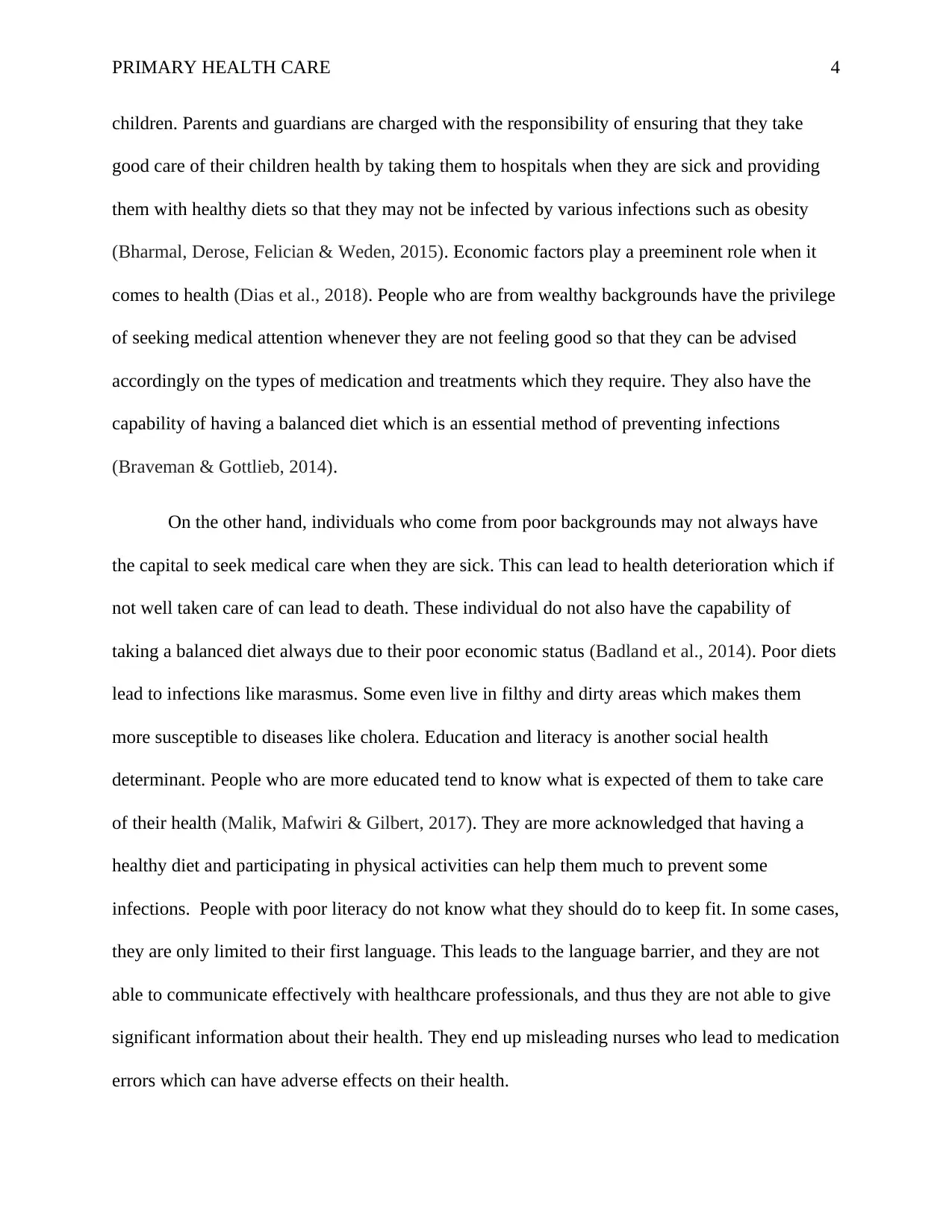
PRIMARY HEALTH CARE 4
children. Parents and guardians are charged with the responsibility of ensuring that they take
good care of their children health by taking them to hospitals when they are sick and providing
them with healthy diets so that they may not be infected by various infections such as obesity
(Bharmal, Derose, Felician & Weden, 2015). Economic factors play a preeminent role when it
comes to health (Dias et al., 2018). People who are from wealthy backgrounds have the privilege
of seeking medical attention whenever they are not feeling good so that they can be advised
accordingly on the types of medication and treatments which they require. They also have the
capability of having a balanced diet which is an essential method of preventing infections
(Braveman & Gottlieb, 2014).
On the other hand, individuals who come from poor backgrounds may not always have
the capital to seek medical care when they are sick. This can lead to health deterioration which if
not well taken care of can lead to death. These individual do not also have the capability of
taking a balanced diet always due to their poor economic status (Badland et al., 2014). Poor diets
lead to infections like marasmus. Some even live in filthy and dirty areas which makes them
more susceptible to diseases like cholera. Education and literacy is another social health
determinant. People who are more educated tend to know what is expected of them to take care
of their health (Malik, Mafwiri & Gilbert, 2017). They are more acknowledged that having a
healthy diet and participating in physical activities can help them much to prevent some
infections. People with poor literacy do not know what they should do to keep fit. In some cases,
they are only limited to their first language. This leads to the language barrier, and they are not
able to communicate effectively with healthcare professionals, and thus they are not able to give
significant information about their health. They end up misleading nurses who lead to medication
errors which can have adverse effects on their health.
children. Parents and guardians are charged with the responsibility of ensuring that they take
good care of their children health by taking them to hospitals when they are sick and providing
them with healthy diets so that they may not be infected by various infections such as obesity
(Bharmal, Derose, Felician & Weden, 2015). Economic factors play a preeminent role when it
comes to health (Dias et al., 2018). People who are from wealthy backgrounds have the privilege
of seeking medical attention whenever they are not feeling good so that they can be advised
accordingly on the types of medication and treatments which they require. They also have the
capability of having a balanced diet which is an essential method of preventing infections
(Braveman & Gottlieb, 2014).
On the other hand, individuals who come from poor backgrounds may not always have
the capital to seek medical care when they are sick. This can lead to health deterioration which if
not well taken care of can lead to death. These individual do not also have the capability of
taking a balanced diet always due to their poor economic status (Badland et al., 2014). Poor diets
lead to infections like marasmus. Some even live in filthy and dirty areas which makes them
more susceptible to diseases like cholera. Education and literacy is another social health
determinant. People who are more educated tend to know what is expected of them to take care
of their health (Malik, Mafwiri & Gilbert, 2017). They are more acknowledged that having a
healthy diet and participating in physical activities can help them much to prevent some
infections. People with poor literacy do not know what they should do to keep fit. In some cases,
they are only limited to their first language. This leads to the language barrier, and they are not
able to communicate effectively with healthcare professionals, and thus they are not able to give
significant information about their health. They end up misleading nurses who lead to medication
errors which can have adverse effects on their health.
Paraphrase This Document
Need a fresh take? Get an instant paraphrase of this document with our AI Paraphraser
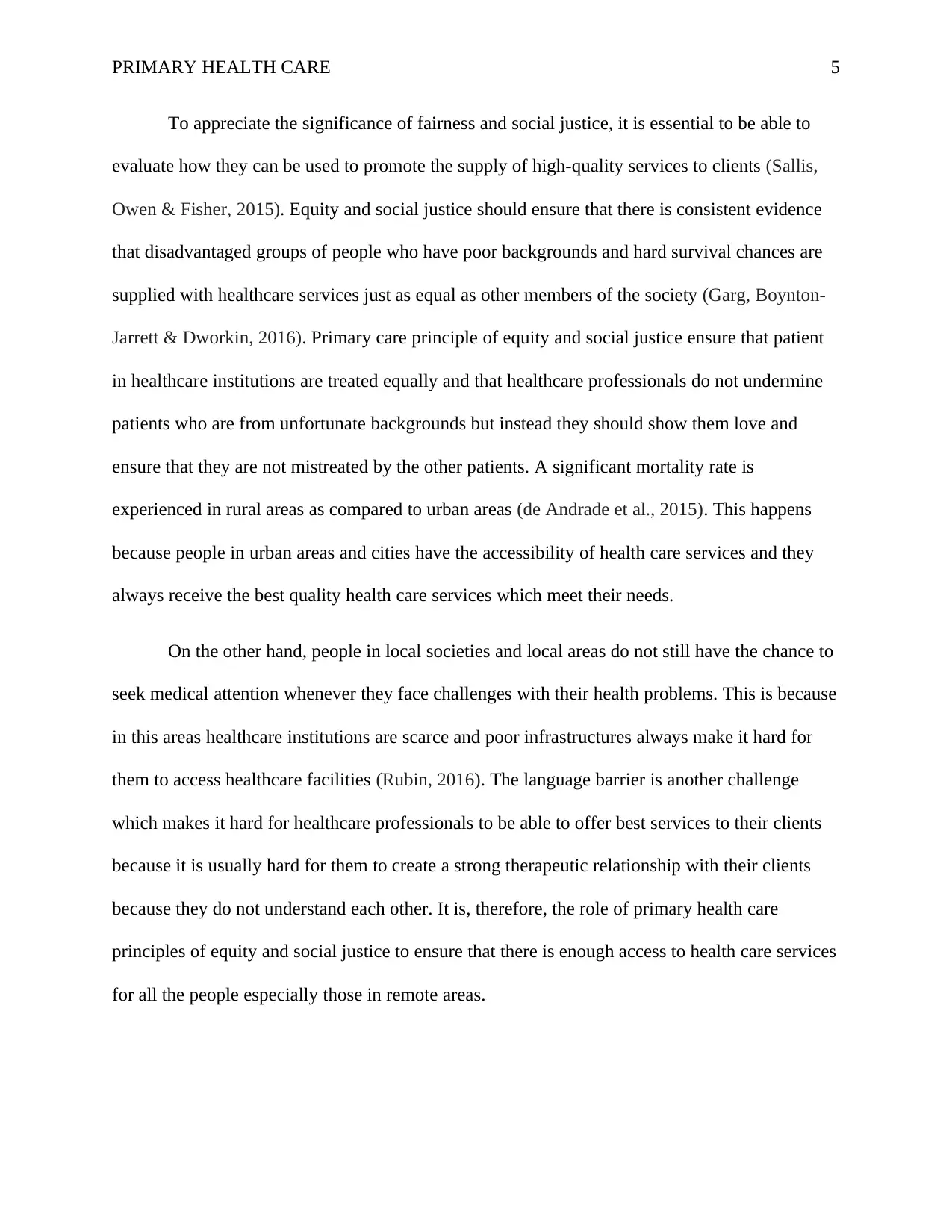
PRIMARY HEALTH CARE 5
To appreciate the significance of fairness and social justice, it is essential to be able to
evaluate how they can be used to promote the supply of high-quality services to clients (Sallis,
Owen & Fisher, 2015). Equity and social justice should ensure that there is consistent evidence
that disadvantaged groups of people who have poor backgrounds and hard survival chances are
supplied with healthcare services just as equal as other members of the society (Garg, Boynton-
Jarrett & Dworkin, 2016). Primary care principle of equity and social justice ensure that patient
in healthcare institutions are treated equally and that healthcare professionals do not undermine
patients who are from unfortunate backgrounds but instead they should show them love and
ensure that they are not mistreated by the other patients. A significant mortality rate is
experienced in rural areas as compared to urban areas (de Andrade et al., 2015). This happens
because people in urban areas and cities have the accessibility of health care services and they
always receive the best quality health care services which meet their needs.
On the other hand, people in local societies and local areas do not still have the chance to
seek medical attention whenever they face challenges with their health problems. This is because
in this areas healthcare institutions are scarce and poor infrastructures always make it hard for
them to access healthcare facilities (Rubin, 2016). The language barrier is another challenge
which makes it hard for healthcare professionals to be able to offer best services to their clients
because it is usually hard for them to create a strong therapeutic relationship with their clients
because they do not understand each other. It is, therefore, the role of primary health care
principles of equity and social justice to ensure that there is enough access to health care services
for all the people especially those in remote areas.
To appreciate the significance of fairness and social justice, it is essential to be able to
evaluate how they can be used to promote the supply of high-quality services to clients (Sallis,
Owen & Fisher, 2015). Equity and social justice should ensure that there is consistent evidence
that disadvantaged groups of people who have poor backgrounds and hard survival chances are
supplied with healthcare services just as equal as other members of the society (Garg, Boynton-
Jarrett & Dworkin, 2016). Primary care principle of equity and social justice ensure that patient
in healthcare institutions are treated equally and that healthcare professionals do not undermine
patients who are from unfortunate backgrounds but instead they should show them love and
ensure that they are not mistreated by the other patients. A significant mortality rate is
experienced in rural areas as compared to urban areas (de Andrade et al., 2015). This happens
because people in urban areas and cities have the accessibility of health care services and they
always receive the best quality health care services which meet their needs.
On the other hand, people in local societies and local areas do not still have the chance to
seek medical attention whenever they face challenges with their health problems. This is because
in this areas healthcare institutions are scarce and poor infrastructures always make it hard for
them to access healthcare facilities (Rubin, 2016). The language barrier is another challenge
which makes it hard for healthcare professionals to be able to offer best services to their clients
because it is usually hard for them to create a strong therapeutic relationship with their clients
because they do not understand each other. It is, therefore, the role of primary health care
principles of equity and social justice to ensure that there is enough access to health care services
for all the people especially those in remote areas.
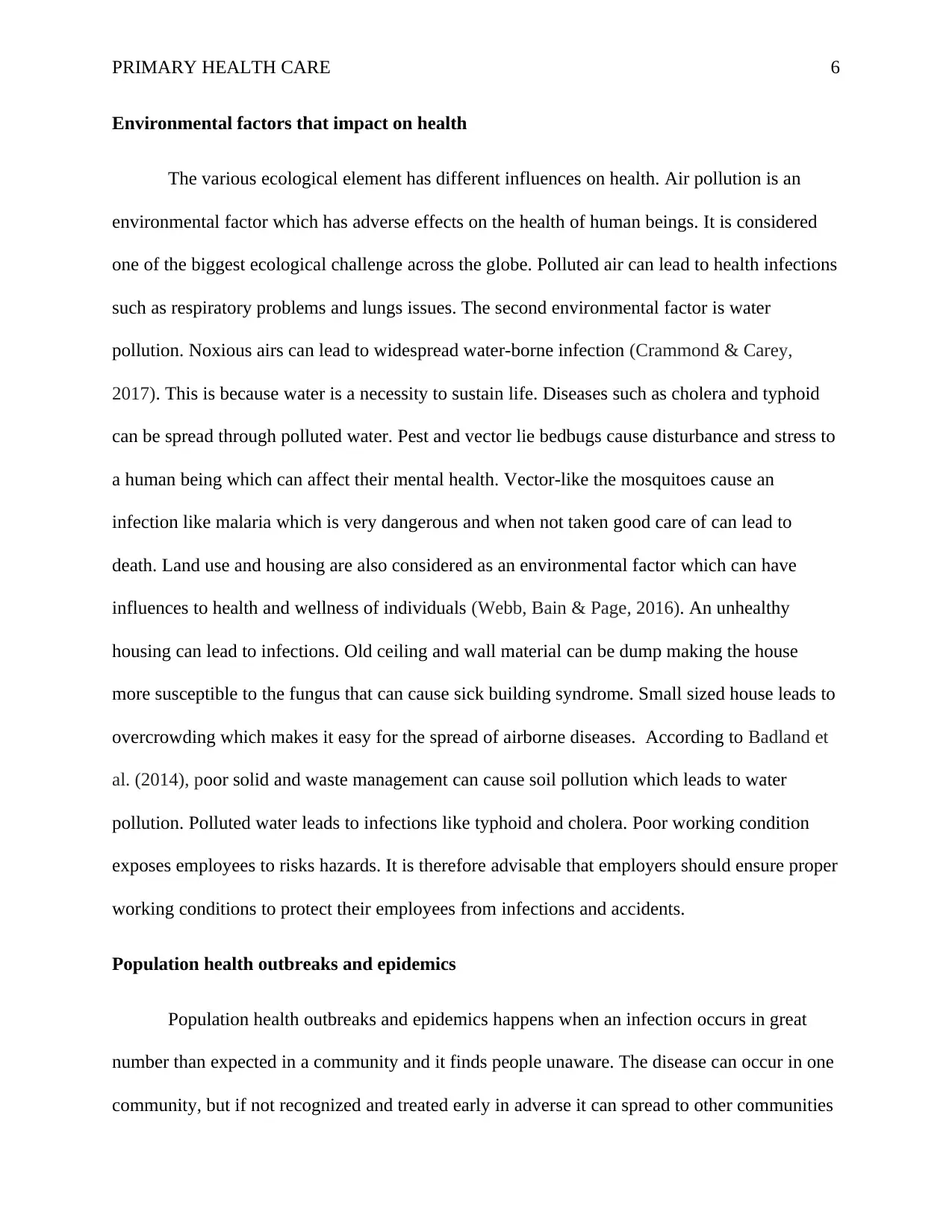
PRIMARY HEALTH CARE 6
Environmental factors that impact on health
The various ecological element has different influences on health. Air pollution is an
environmental factor which has adverse effects on the health of human beings. It is considered
one of the biggest ecological challenge across the globe. Polluted air can lead to health infections
such as respiratory problems and lungs issues. The second environmental factor is water
pollution. Noxious airs can lead to widespread water-borne infection (Crammond & Carey,
2017). This is because water is a necessity to sustain life. Diseases such as cholera and typhoid
can be spread through polluted water. Pest and vector lie bedbugs cause disturbance and stress to
a human being which can affect their mental health. Vector-like the mosquitoes cause an
infection like malaria which is very dangerous and when not taken good care of can lead to
death. Land use and housing are also considered as an environmental factor which can have
influences to health and wellness of individuals (Webb, Bain & Page, 2016). An unhealthy
housing can lead to infections. Old ceiling and wall material can be dump making the house
more susceptible to the fungus that can cause sick building syndrome. Small sized house leads to
overcrowding which makes it easy for the spread of airborne diseases. According to Badland et
al. (2014), poor solid and waste management can cause soil pollution which leads to water
pollution. Polluted water leads to infections like typhoid and cholera. Poor working condition
exposes employees to risks hazards. It is therefore advisable that employers should ensure proper
working conditions to protect their employees from infections and accidents.
Population health outbreaks and epidemics
Population health outbreaks and epidemics happens when an infection occurs in great
number than expected in a community and it finds people unaware. The disease can occur in one
community, but if not recognized and treated early in adverse it can spread to other communities
Environmental factors that impact on health
The various ecological element has different influences on health. Air pollution is an
environmental factor which has adverse effects on the health of human beings. It is considered
one of the biggest ecological challenge across the globe. Polluted air can lead to health infections
such as respiratory problems and lungs issues. The second environmental factor is water
pollution. Noxious airs can lead to widespread water-borne infection (Crammond & Carey,
2017). This is because water is a necessity to sustain life. Diseases such as cholera and typhoid
can be spread through polluted water. Pest and vector lie bedbugs cause disturbance and stress to
a human being which can affect their mental health. Vector-like the mosquitoes cause an
infection like malaria which is very dangerous and when not taken good care of can lead to
death. Land use and housing are also considered as an environmental factor which can have
influences to health and wellness of individuals (Webb, Bain & Page, 2016). An unhealthy
housing can lead to infections. Old ceiling and wall material can be dump making the house
more susceptible to the fungus that can cause sick building syndrome. Small sized house leads to
overcrowding which makes it easy for the spread of airborne diseases. According to Badland et
al. (2014), poor solid and waste management can cause soil pollution which leads to water
pollution. Polluted water leads to infections like typhoid and cholera. Poor working condition
exposes employees to risks hazards. It is therefore advisable that employers should ensure proper
working conditions to protect their employees from infections and accidents.
Population health outbreaks and epidemics
Population health outbreaks and epidemics happens when an infection occurs in great
number than expected in a community and it finds people unaware. The disease can occur in one
community, but if not recognized and treated early in adverse it can spread to other communities
⊘ This is a preview!⊘
Do you want full access?
Subscribe today to unlock all pages.

Trusted by 1+ million students worldwide
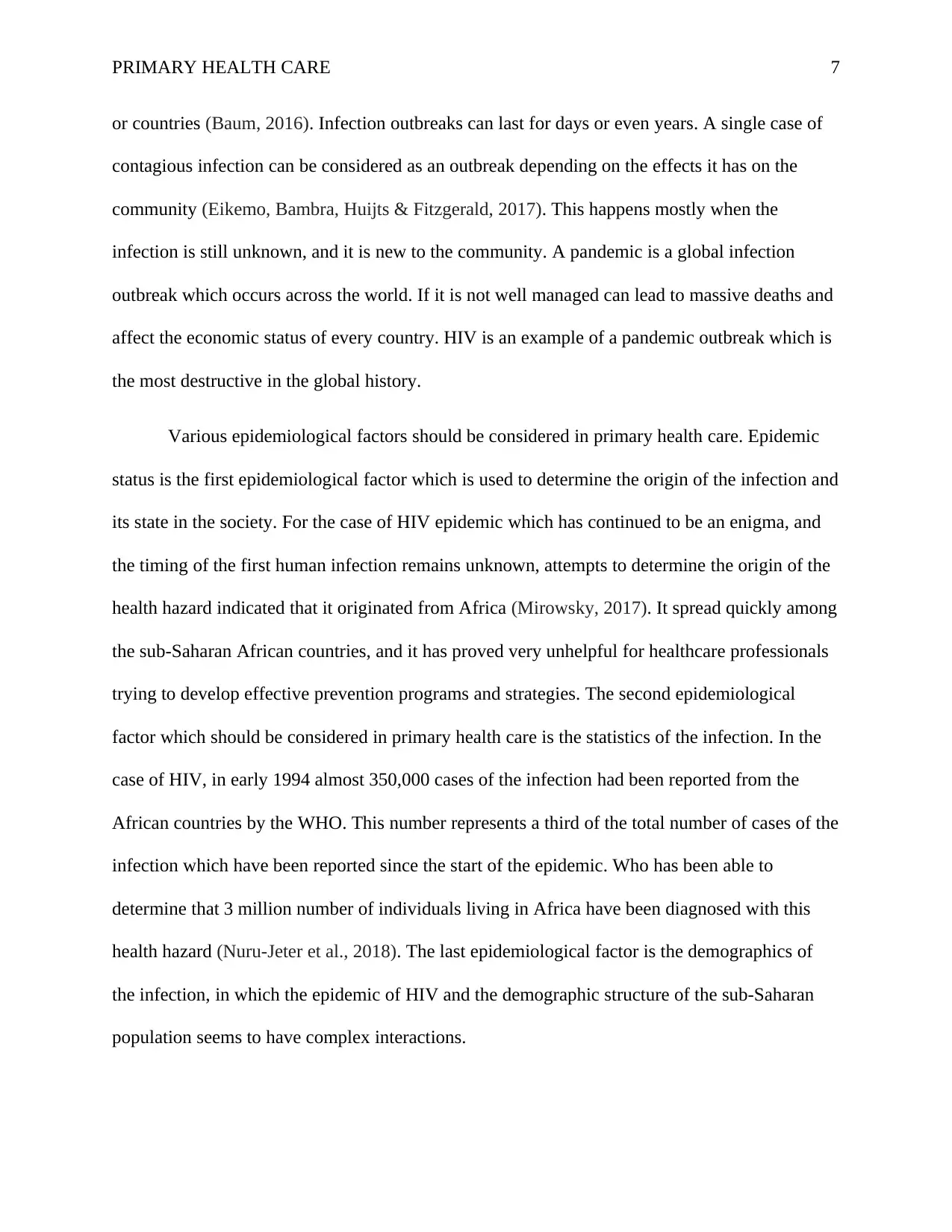
PRIMARY HEALTH CARE 7
or countries (Baum, 2016). Infection outbreaks can last for days or even years. A single case of
contagious infection can be considered as an outbreak depending on the effects it has on the
community (Eikemo, Bambra, Huijts & Fitzgerald, 2017). This happens mostly when the
infection is still unknown, and it is new to the community. A pandemic is a global infection
outbreak which occurs across the world. If it is not well managed can lead to massive deaths and
affect the economic status of every country. HIV is an example of a pandemic outbreak which is
the most destructive in the global history.
Various epidemiological factors should be considered in primary health care. Epidemic
status is the first epidemiological factor which is used to determine the origin of the infection and
its state in the society. For the case of HIV epidemic which has continued to be an enigma, and
the timing of the first human infection remains unknown, attempts to determine the origin of the
health hazard indicated that it originated from Africa (Mirowsky, 2017). It spread quickly among
the sub-Saharan African countries, and it has proved very unhelpful for healthcare professionals
trying to develop effective prevention programs and strategies. The second epidemiological
factor which should be considered in primary health care is the statistics of the infection. In the
case of HIV, in early 1994 almost 350,000 cases of the infection had been reported from the
African countries by the WHO. This number represents a third of the total number of cases of the
infection which have been reported since the start of the epidemic. Who has been able to
determine that 3 million number of individuals living in Africa have been diagnosed with this
health hazard (Nuru-Jeter et al., 2018). The last epidemiological factor is the demographics of
the infection, in which the epidemic of HIV and the demographic structure of the sub-Saharan
population seems to have complex interactions.
or countries (Baum, 2016). Infection outbreaks can last for days or even years. A single case of
contagious infection can be considered as an outbreak depending on the effects it has on the
community (Eikemo, Bambra, Huijts & Fitzgerald, 2017). This happens mostly when the
infection is still unknown, and it is new to the community. A pandemic is a global infection
outbreak which occurs across the world. If it is not well managed can lead to massive deaths and
affect the economic status of every country. HIV is an example of a pandemic outbreak which is
the most destructive in the global history.
Various epidemiological factors should be considered in primary health care. Epidemic
status is the first epidemiological factor which is used to determine the origin of the infection and
its state in the society. For the case of HIV epidemic which has continued to be an enigma, and
the timing of the first human infection remains unknown, attempts to determine the origin of the
health hazard indicated that it originated from Africa (Mirowsky, 2017). It spread quickly among
the sub-Saharan African countries, and it has proved very unhelpful for healthcare professionals
trying to develop effective prevention programs and strategies. The second epidemiological
factor which should be considered in primary health care is the statistics of the infection. In the
case of HIV, in early 1994 almost 350,000 cases of the infection had been reported from the
African countries by the WHO. This number represents a third of the total number of cases of the
infection which have been reported since the start of the epidemic. Who has been able to
determine that 3 million number of individuals living in Africa have been diagnosed with this
health hazard (Nuru-Jeter et al., 2018). The last epidemiological factor is the demographics of
the infection, in which the epidemic of HIV and the demographic structure of the sub-Saharan
population seems to have complex interactions.
Paraphrase This Document
Need a fresh take? Get an instant paraphrase of this document with our AI Paraphraser
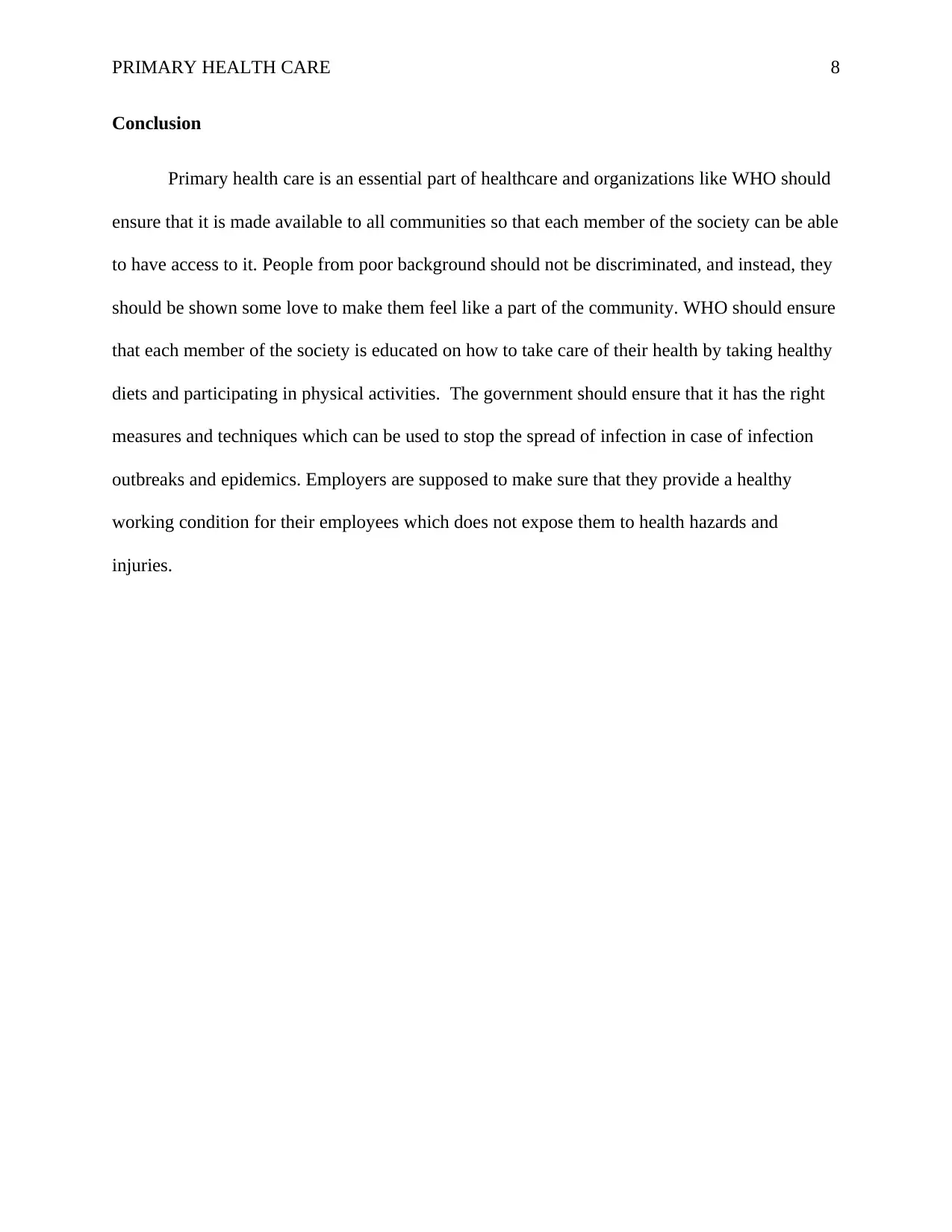
PRIMARY HEALTH CARE 8
Conclusion
Primary health care is an essential part of healthcare and organizations like WHO should
ensure that it is made available to all communities so that each member of the society can be able
to have access to it. People from poor background should not be discriminated, and instead, they
should be shown some love to make them feel like a part of the community. WHO should ensure
that each member of the society is educated on how to take care of their health by taking healthy
diets and participating in physical activities. The government should ensure that it has the right
measures and techniques which can be used to stop the spread of infection in case of infection
outbreaks and epidemics. Employers are supposed to make sure that they provide a healthy
working condition for their employees which does not expose them to health hazards and
injuries.
Conclusion
Primary health care is an essential part of healthcare and organizations like WHO should
ensure that it is made available to all communities so that each member of the society can be able
to have access to it. People from poor background should not be discriminated, and instead, they
should be shown some love to make them feel like a part of the community. WHO should ensure
that each member of the society is educated on how to take care of their health by taking healthy
diets and participating in physical activities. The government should ensure that it has the right
measures and techniques which can be used to stop the spread of infection in case of infection
outbreaks and epidemics. Employers are supposed to make sure that they provide a healthy
working condition for their employees which does not expose them to health hazards and
injuries.
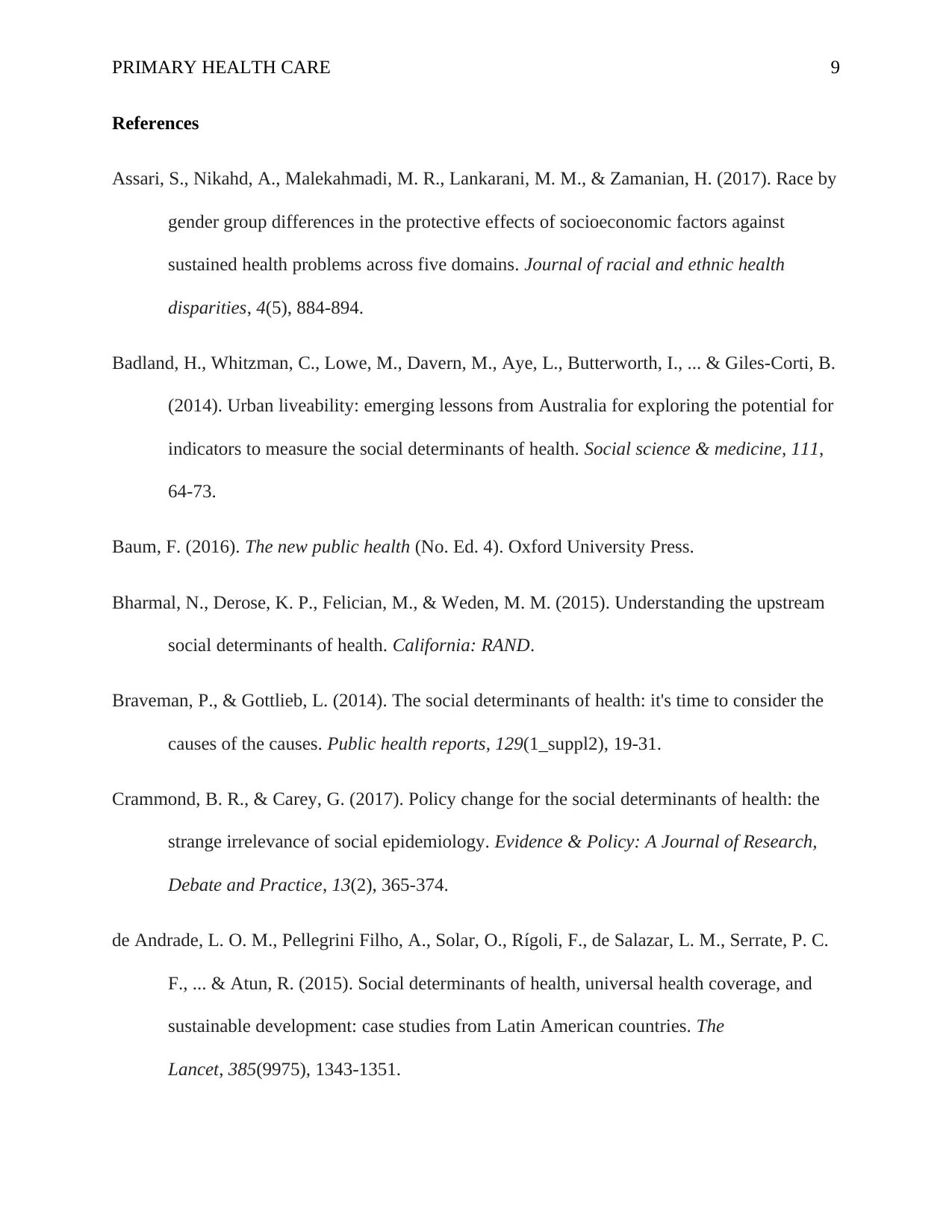
PRIMARY HEALTH CARE 9
References
Assari, S., Nikahd, A., Malekahmadi, M. R., Lankarani, M. M., & Zamanian, H. (2017). Race by
gender group differences in the protective effects of socioeconomic factors against
sustained health problems across five domains. Journal of racial and ethnic health
disparities, 4(5), 884-894.
Badland, H., Whitzman, C., Lowe, M., Davern, M., Aye, L., Butterworth, I., ... & Giles-Corti, B.
(2014). Urban liveability: emerging lessons from Australia for exploring the potential for
indicators to measure the social determinants of health. Social science & medicine, 111,
64-73.
Baum, F. (2016). The new public health (No. Ed. 4). Oxford University Press.
Bharmal, N., Derose, K. P., Felician, M., & Weden, M. M. (2015). Understanding the upstream
social determinants of health. California: RAND.
Braveman, P., & Gottlieb, L. (2014). The social determinants of health: it's time to consider the
causes of the causes. Public health reports, 129(1_suppl2), 19-31.
Crammond, B. R., & Carey, G. (2017). Policy change for the social determinants of health: the
strange irrelevance of social epidemiology. Evidence & Policy: A Journal of Research,
Debate and Practice, 13(2), 365-374.
de Andrade, L. O. M., Pellegrini Filho, A., Solar, O., Rígoli, F., de Salazar, L. M., Serrate, P. C.
F., ... & Atun, R. (2015). Social determinants of health, universal health coverage, and
sustainable development: case studies from Latin American countries. The
Lancet, 385(9975), 1343-1351.
References
Assari, S., Nikahd, A., Malekahmadi, M. R., Lankarani, M. M., & Zamanian, H. (2017). Race by
gender group differences in the protective effects of socioeconomic factors against
sustained health problems across five domains. Journal of racial and ethnic health
disparities, 4(5), 884-894.
Badland, H., Whitzman, C., Lowe, M., Davern, M., Aye, L., Butterworth, I., ... & Giles-Corti, B.
(2014). Urban liveability: emerging lessons from Australia for exploring the potential for
indicators to measure the social determinants of health. Social science & medicine, 111,
64-73.
Baum, F. (2016). The new public health (No. Ed. 4). Oxford University Press.
Bharmal, N., Derose, K. P., Felician, M., & Weden, M. M. (2015). Understanding the upstream
social determinants of health. California: RAND.
Braveman, P., & Gottlieb, L. (2014). The social determinants of health: it's time to consider the
causes of the causes. Public health reports, 129(1_suppl2), 19-31.
Crammond, B. R., & Carey, G. (2017). Policy change for the social determinants of health: the
strange irrelevance of social epidemiology. Evidence & Policy: A Journal of Research,
Debate and Practice, 13(2), 365-374.
de Andrade, L. O. M., Pellegrini Filho, A., Solar, O., Rígoli, F., de Salazar, L. M., Serrate, P. C.
F., ... & Atun, R. (2015). Social determinants of health, universal health coverage, and
sustainable development: case studies from Latin American countries. The
Lancet, 385(9975), 1343-1351.
⊘ This is a preview!⊘
Do you want full access?
Subscribe today to unlock all pages.

Trusted by 1+ million students worldwide
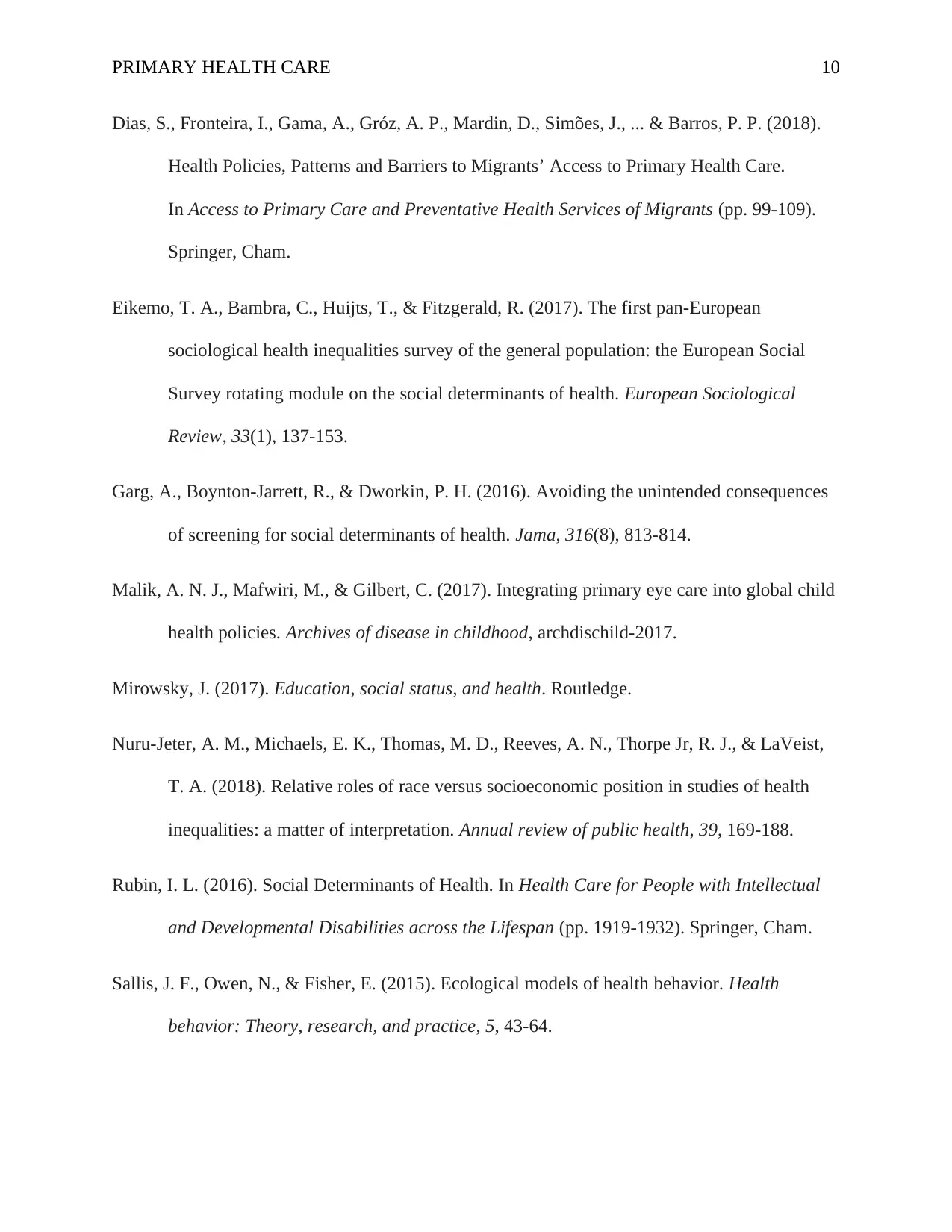
PRIMARY HEALTH CARE 10
Dias, S., Fronteira, I., Gama, A., Gróz, A. P., Mardin, D., Simões, J., ... & Barros, P. P. (2018).
Health Policies, Patterns and Barriers to Migrants’ Access to Primary Health Care.
In Access to Primary Care and Preventative Health Services of Migrants (pp. 99-109).
Springer, Cham.
Eikemo, T. A., Bambra, C., Huijts, T., & Fitzgerald, R. (2017). The first pan-European
sociological health inequalities survey of the general population: the European Social
Survey rotating module on the social determinants of health. European Sociological
Review, 33(1), 137-153.
Garg, A., Boynton-Jarrett, R., & Dworkin, P. H. (2016). Avoiding the unintended consequences
of screening for social determinants of health. Jama, 316(8), 813-814.
Malik, A. N. J., Mafwiri, M., & Gilbert, C. (2017). Integrating primary eye care into global child
health policies. Archives of disease in childhood, archdischild-2017.
Mirowsky, J. (2017). Education, social status, and health. Routledge.
Nuru-Jeter, A. M., Michaels, E. K., Thomas, M. D., Reeves, A. N., Thorpe Jr, R. J., & LaVeist,
T. A. (2018). Relative roles of race versus socioeconomic position in studies of health
inequalities: a matter of interpretation. Annual review of public health, 39, 169-188.
Rubin, I. L. (2016). Social Determinants of Health. In Health Care for People with Intellectual
and Developmental Disabilities across the Lifespan (pp. 1919-1932). Springer, Cham.
Sallis, J. F., Owen, N., & Fisher, E. (2015). Ecological models of health behavior. Health
behavior: Theory, research, and practice, 5, 43-64.
Dias, S., Fronteira, I., Gama, A., Gróz, A. P., Mardin, D., Simões, J., ... & Barros, P. P. (2018).
Health Policies, Patterns and Barriers to Migrants’ Access to Primary Health Care.
In Access to Primary Care and Preventative Health Services of Migrants (pp. 99-109).
Springer, Cham.
Eikemo, T. A., Bambra, C., Huijts, T., & Fitzgerald, R. (2017). The first pan-European
sociological health inequalities survey of the general population: the European Social
Survey rotating module on the social determinants of health. European Sociological
Review, 33(1), 137-153.
Garg, A., Boynton-Jarrett, R., & Dworkin, P. H. (2016). Avoiding the unintended consequences
of screening for social determinants of health. Jama, 316(8), 813-814.
Malik, A. N. J., Mafwiri, M., & Gilbert, C. (2017). Integrating primary eye care into global child
health policies. Archives of disease in childhood, archdischild-2017.
Mirowsky, J. (2017). Education, social status, and health. Routledge.
Nuru-Jeter, A. M., Michaels, E. K., Thomas, M. D., Reeves, A. N., Thorpe Jr, R. J., & LaVeist,
T. A. (2018). Relative roles of race versus socioeconomic position in studies of health
inequalities: a matter of interpretation. Annual review of public health, 39, 169-188.
Rubin, I. L. (2016). Social Determinants of Health. In Health Care for People with Intellectual
and Developmental Disabilities across the Lifespan (pp. 1919-1932). Springer, Cham.
Sallis, J. F., Owen, N., & Fisher, E. (2015). Ecological models of health behavior. Health
behavior: Theory, research, and practice, 5, 43-64.
Paraphrase This Document
Need a fresh take? Get an instant paraphrase of this document with our AI Paraphraser
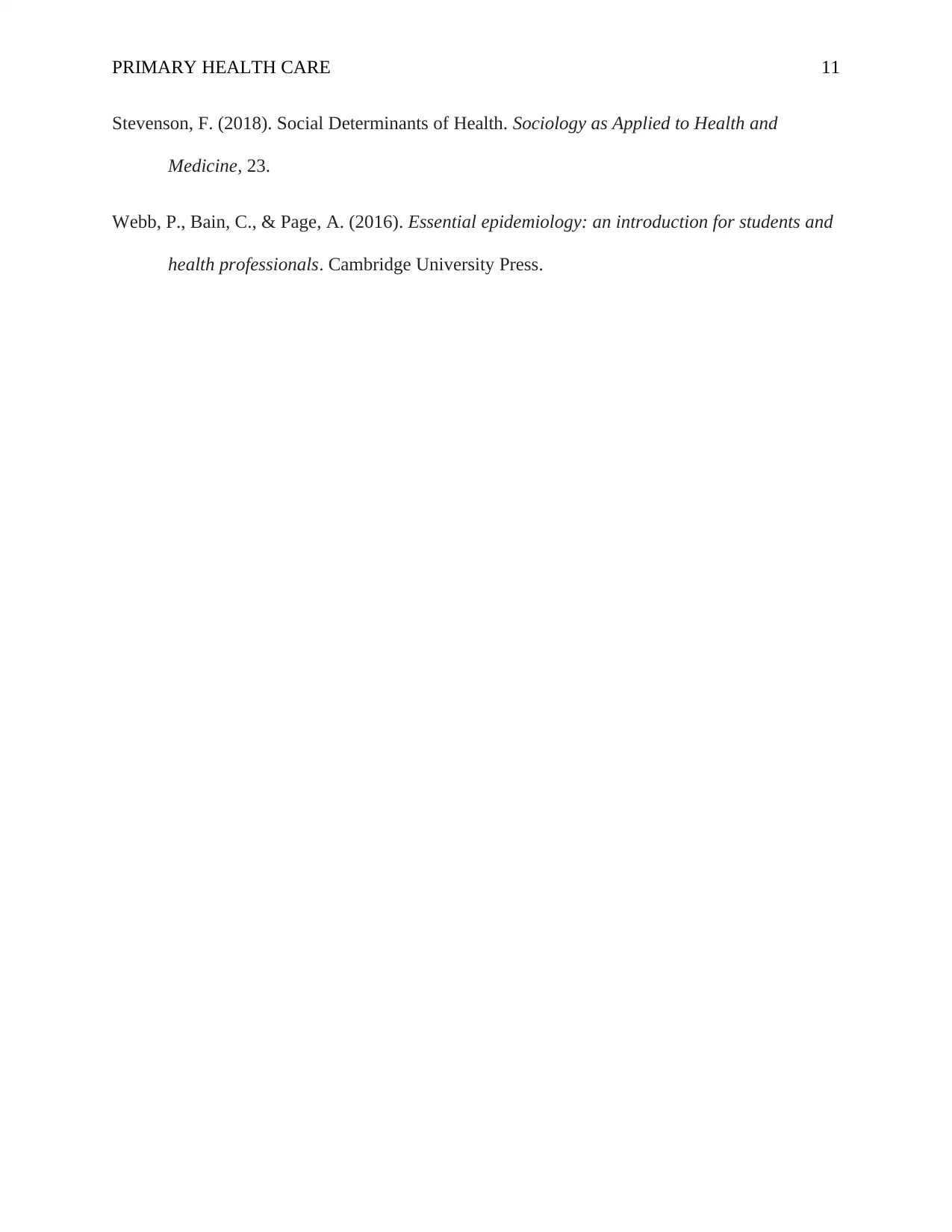
PRIMARY HEALTH CARE 11
Stevenson, F. (2018). Social Determinants of Health. Sociology as Applied to Health and
Medicine, 23.
Webb, P., Bain, C., & Page, A. (2016). Essential epidemiology: an introduction for students and
health professionals. Cambridge University Press.
Stevenson, F. (2018). Social Determinants of Health. Sociology as Applied to Health and
Medicine, 23.
Webb, P., Bain, C., & Page, A. (2016). Essential epidemiology: an introduction for students and
health professionals. Cambridge University Press.
1 out of 11
Related Documents
Your All-in-One AI-Powered Toolkit for Academic Success.
+13062052269
info@desklib.com
Available 24*7 on WhatsApp / Email
![[object Object]](/_next/static/media/star-bottom.7253800d.svg)
Unlock your academic potential
Copyright © 2020–2025 A2Z Services. All Rights Reserved. Developed and managed by ZUCOL.





